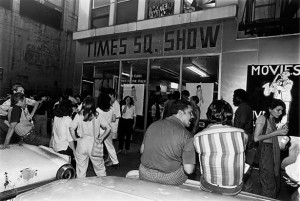Tagging is reported to have emerged in the mid-1960s, and was seen as gang-related phenomena: its primary concern was marking territory. By 1970, graffiti writing had emerged in earnest, and speedily acquired a large following among marginalized youth living in the outer boroughs. Cedar Lewisohn is unequivocal in his characterization of modern graffiti as constitutive of a distinctive rupture in Art History:
No other movement since cubism or surrealism has developed such a distinctly new language […] the phenomenon of the dispossessed young people in New York City in the 1970s and early 1980s channeling their frustration and boredom into making visual art—not music, not sport, but art—is unprecedented (Lewinsohn, 31).
Unburdened by previous conventions in fine art, graffiti utilized pop culture in order to crystallize its distinctive set of referents. Graffiti crews roamed around New York at night, looking for spaces to cover in their work. The subway system of New York was utilized extensively in this respect, where Graffiti writers often snuck into subway depots to paint the trains housed therein. This led to the emergence of ‘Wild Style’, an intricate form of typography that features interwoven and overlapping letters, which sought to echo the kinetic energy of the trains on which they were displayed.
Numerous figures and crews would gain cult-like status during this time through their distinctive tags; one of the primary objectives of tagging is to make your work uncopyable. The likes of Fab Five Freddy, Futura 2000, Lee Quinones (interestingly, much of Lee’s typography is derivative of WPA work, despite his status as a graffiti writer), Lady Pink, Zephyr, and The Cold Crush Brothers all gained notoriety during this period.
By the 1980s, Graffiti art started to gain more recognition in the public sphere due its associations with Hip-Hop. It reached Europe by 1982, further heightening its prestige. The release of Martha Cooper and Henry Chalfant’s magnificent book ‘Subway Art’ in 1984 abetted this process, bringing modern graffiti to countries in which it was previously unknown. Yet the grass-roots movement they had documented was already on its way out by the time of the book’s publication; the art market had taken note several years earlier.
The fact was many artists were attracted by the prospect of financial remuneration, and sought to be exhibited in the gallery circuit as early as 1980. Futura 2000 saw Fab 5 Freddy and Hugo Martinez as instrumental in this process. The Times Square Show of 1980, the New York New Wave show in 1981, as well as Tony Shafrazi Gallery and The Sidney Janis Gallery exhibited many of these artists for the first time. Yet these shows would be remembered more for inaugurating the careers of two the giants of the graffiti/street art scene: Keith Haring and Jean-Michel Basquiat.
By 1989, the subway became virtually graffiti-free through the work Mayors John Lindsay and Ed Koch. In the ensuing years, graffiti became less and less of a peripheral phenomenon, as it was utilized by the fashion industry and other corporate entities for marketing purposes. Graffiti had moved into the mainstream.


